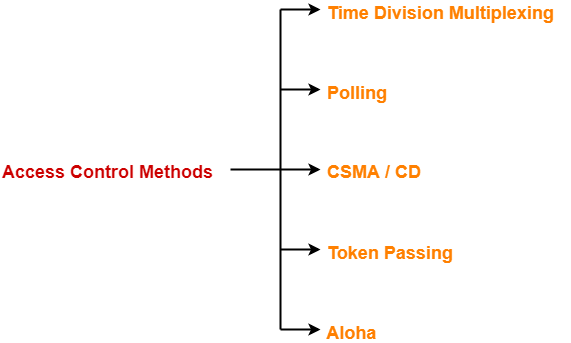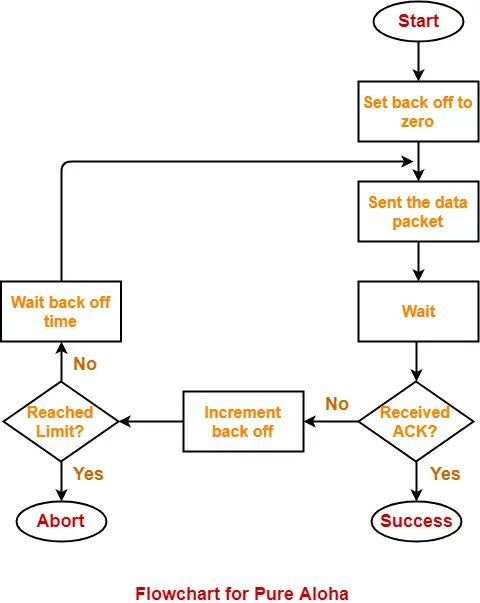Access Control in Networking-
Before you go through this article, make sure that you have gone through the previous article on Access Control.
We have discussed-
- Access Control is a mechanism that controls the access of stations to the transmission link.
- Broadcast links require the access control mechanism.
- There are various access control methods-

In this article, we will discuss about Aloha and its versions.
Aloha-
There are two different versions of Aloha-

- Pure Aloha
- Slotted Aloha
1. Pure Aloha-
- It allows the stations to transmit data at any time whenever they want.
- After transmitting the data packet, station waits for some time.
Then, following 2 cases are possible-
Case-01:
- Transmitting station receives an acknowledgement from the receiving station.
- In this case, transmitting station assumes that the transmission is successful.
Case-02:
- Transmitting station does not receive any acknowledgement within specified time from the receiving station.
- In this case, transmitting station assumes that the transmission is unsuccessful.
Then,
- Transmitting station uses a Back Off Strategy and waits for some random amount of time.
- After back off time, it transmits the data packet again.
- It keeps trying until the back off limit is reached after which it aborts the transmission.

Efficiency-
| Efficiency of Pure Aloha (η) = G x e-2G |
where G = Number of stations willing to transmit data
Maximum Efficiency-
For maximum efficiency,
- We put dη / dG = 0
- Maximum value of η occurs at G = 1/2
- Substituting G = 1/2 in the above expression, we get-
Maximum efficiency of Pure Aloha
= 1/2 x e-2 x 1/2
= 1 / 2e
= 0.184
= 18.4%
Thus,
| Maximum Efficiency of Pure Aloha (η) = 18.4% |
The maximum efficiency of Pure Aloha is very less due to large number of collisions.
2. Slotted Aloha-
- Slotted Aloha divides the time of shared channel into discrete intervals called as time slots.
- Any station can transmit its data in any time slot.
- The only condition is that station must start its transmission from the beginning of the time slot.
- If the beginning of the slot is missed, then station has to wait until the beginning of the next time slot.
- A collision may occur if two or more stations try to transmit data at the beginning of the same time slot.
Efficiency-
| Efficiency of Slotted Aloha (η) = G x e-G |
where G = Number of stations willing to transmit data at the beginning of the same time slot
Maximum Efficiency-
For maximum efficiency,
- We put dη / dG = 0
- Maximum value of η occurs at G = 1
- Substituting G = 1 in the above expression, we get-
Maximum efficiency of Slotted Aloha
= 1 x e-1
= 1 / e
= 0.368
= 36.8%
Thus,
| Maximum Efficiency of Slotted Aloha (η) = 36.8% |
The maximum efficiency of Slotted Aloha is high due to less number of collisions.
Difference Between Pure Aloha And Slotted Aloha-
| Pure Aloha | Slotted Aloha |
| Any station can transmit the data at any time. | Any station can transmit the data at the beginning of any time slot. |
| The time is continuous and not globally synchronized. | The time is discrete and globally synchronized. |
| Vulnerable time in which collision may occur
= 2 x Tt |
Vulnerable time in which collision may occur
= Tt |
| Probability of successful transmission of data packet
= G x e-2G |
Probability of successful transmission of data packet
= G x e-G |
| Maximum efficiency = 18.4%
(Occurs at G = 1/2) |
Maximum efficiency = 36.8%
( Occurs at G = 1) |
| The main advantage of pure aloha is its simplicity in implementation. | The main advantage of slotted aloha is that it reduces the number of collisions to half and doubles the efficiency of pure aloha. |
PRACTICE PROBLEM BASED ON PURE ALOHA AND SLOTTED ALOHA-
Problem-
A group of N stations share 100 Kbps slotted ALOHA channel. Each station output a 500 bits frame on an average of 5000 ms even if previous one has not been sent. What is the required value of N?
Solution-
Throughput Of One Station-
Throughput of each station
= Number of bits sent per second
= 500 bits / 5000 ms
= 500 bits / (5000 x 10-3 sec)
= 100 bits/sec
Throughput Of Slotted Aloha-
Throughput of slotted aloha
= Efficiency x Bandwidth
= 0.368 x 100 Kbps
= 36.8 Kbps
Total Number Of Stations-
Throughput of slotted aloha = Total number of stations x Throughput of each station
Substituting the values, we get-
36.8 Kbps = N x 100 bits/sec
∴ N = 368
Thus, required value of N = 368.
To gain better understanding about Aloha,
Next Article- Ethernet | Ethernet Frame Format
Get more notes and other study material of Computer Networks.
Watch video lectures by visiting our YouTube channel LearnVidFun.